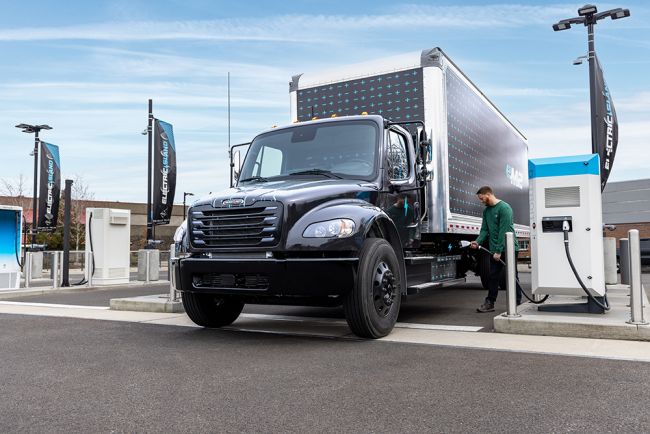
Navigating the EV Landscape in 2025: Top Trends to Watch
The path of progress is never a straight line, and the road to electric vehicle adoption is no exception. While there may be zigs and zags, the market for fleet vehicles is trucking toward further adoption of EVs for light- and medium-duty applications.
The regulatory environment is a big driver of change. In March 2024, the Biden administration shifted emphasis in the EV landscape, focusing on performance standards rather than mandating specific technologies.
The final rule from the U.S. Environmental Protection Agency, titled “Multi-Pollutant Emissions Standards for Model Years 2027 and Later Light-Duty and Medium-Duty Vehicles” (see www.epa.gov/regulations-emissions-vehicles-and-engines/final-rule-multi-pollutant-emissions-standards-model), and the U.S. Department of Energy’s revised Petroleum-Equivalent Fuel Economy Calculation (see www.federalregister.gov/documents/2024/03/29/2024-06101/petroleum-equivalent-fuel-economy-calculation) support performance standards for 2027-2032 model years rather than require use of specific applications, with the goal of reducing emissions by more than 50% over the previous standards.
Industry advocates say automakers will have more flexibility to pursue additional fuel-saving technologies, including hybrids, turbocharging and other internal combustion engine enhancements.
The future of EVs under the second Trump administration is still evolving; however, the overall market is steering toward electrification.
“In the midst of uncertainty, I think it’s important to point out the innovation, the investment trajectory and all the work that has been done – particularly in electrifying fleets – so far and will continue as the market pushes in that direction,” said Genevieve Cullen, president of the Electric Drive Transportation Association (https://electricdrive.org).
Electric utilities are on the front lines of this trend, accommodating the charging demands of their commercial customer base as well as the infrastructure for their in-house fleets.
According to Cullen, “There are movements to work with public utility commissions to allow utilities to make investments in advance of a requested need to build charging infrastructure to help incentivize EV adoption.”
Projected Increase in EV Adoption
Recent survey data from Cox Automotive indicated that 14% of U.S. fleets currently operate EVs, and 87% expect to add them to their fleets within the next five years (see www.coxautoinc.com/market-insights/future-of-fleets-path-to-ev-adoption/). Those operators estimated EVs would be roughly half their fleet in the next five years.
The Cox Automotive survey data also revealed that commercial fleets that have already adopted EVs have a 90% likelihood of obtaining additional EVs during their next acquisition cycle.
“I think that is probably the most compelling narrative because you’re hearing from people who have already done it as opposed to people who don’t really have any experience with it,” said Stuart Gardner, executive director of Generation180 (https://generation180.org), a national nonprofit organization that promotes clean energy.
Utility fleet operators continue to turn to fleet electrification to help reduce total cost of ownership and operating costs while meeting environmental goals.
Cullen noted that more than 30 electrified medium- and heavy-duty truck models are expected to hit the market in the near future, joining the core group of light-duty consumer-oriented vehicles.
Public Policy
Tax credits for clean vehicles and charging infrastructure investments could be under scrutiny during the second Trump administration. However, state and local governments also promote electrified fleets that are cleaner and quieter; they could provide incentives to move fleets in that direction, Cullen said.
Utilities may continue with electrification efforts to meet emissions reduction targets set by municipalities or shareholders.
Charging
For fleet operators with EVs, depot charging is often the best option compared to regularly using public charging networks. Technology advancements are helping operators recharge vehicles faster and smarter to better manage battery life.
Home charging may be an option for fleet operators with vehicles that aren’t regularly returned to the depot.
The Federal Highway Administration is finalizing regulations that recognize the unique needs of medium- and heavy-duty charging facilities under the National Electric Vehicle Infrastructure Formula Program and the Charging and Fueling Infrastructure Discretionary Grant Program.
Batteries
A truck that doesn’t need a 300-mile range can have a smaller, less expensive battery. That means fleet vehicles operated within known ranges and returned to the depot for daily charging could fulfill their missions for lower acquisition costs.
Smaller batteries also mean that standard Level 2 stations could top up a battery overnight without the need for expensive Level 3 fast chargers.
Data-Driven Management
EVs produce a flood of data that can guide fleet managers in analyzing fuel and emissions savings, battery life, downtime and more. Tracking fuel savings and reduced emissions can support the business case for EV investment.
Performance data provides insight into the expected life of each vehicle so that fleets can cull those with rising maintenance costs. At the same time, replacement cycles can be extended for vehicles still performing well.
Hybrids
Automakers will bump up hybrid output as a transitional measure while they improve battery technology and reduce production costs for EVs.
“Hybrids are totally familiar to drivers, but they can get 50 to 60 mpg, so it’s a way for automakers to reach the fuel economy standards faster,” Gardner said.
Hybrid vehicles also offer towing and hauling capacity similar to gas engines but with better fuel economy and lower emissions.
Ford, Hino and Ram are among the automakers committed to expanding their range of commercial hybrid vehicles.
About the Author: Gary L. Wollenhaupt is a Colorado Springs-based freelance writer who covers the transportation, energy and technology sectors for a variety of publications and companies.

